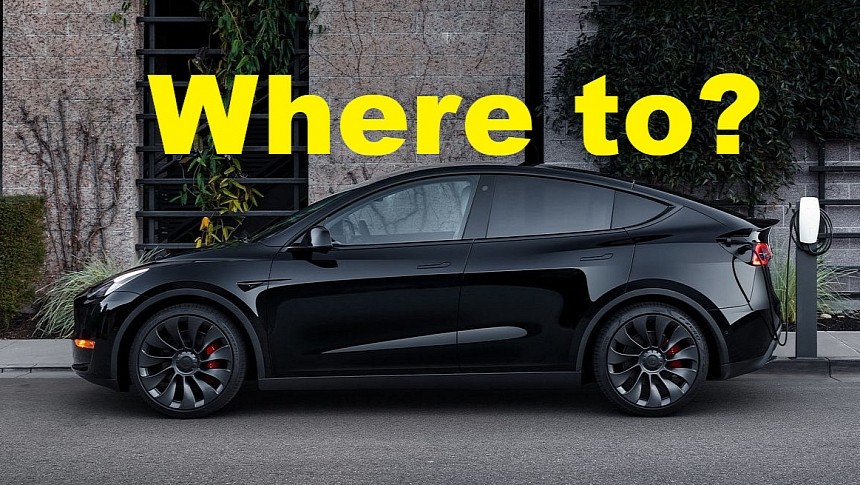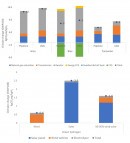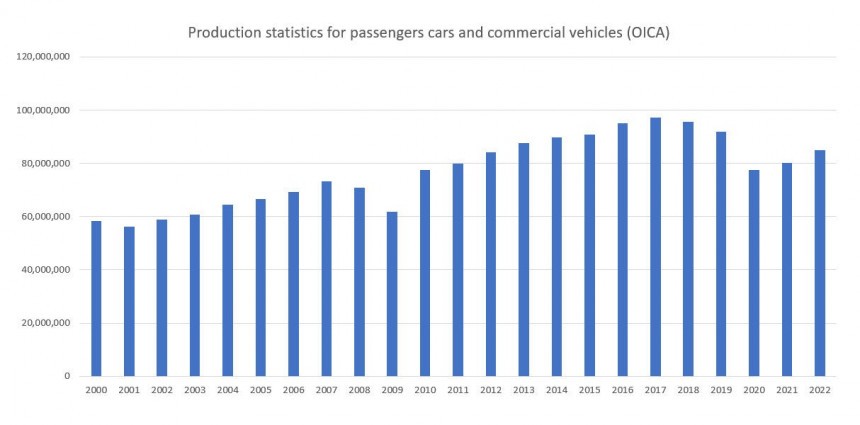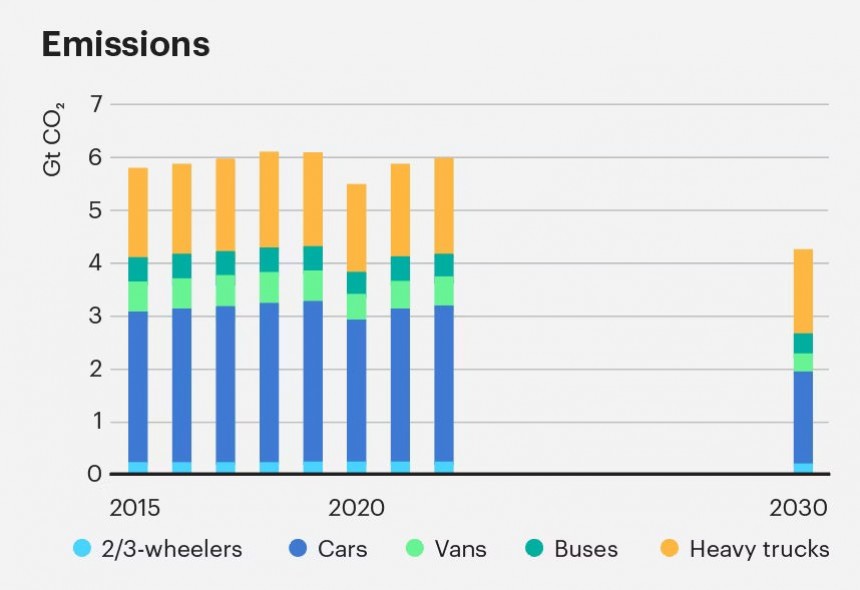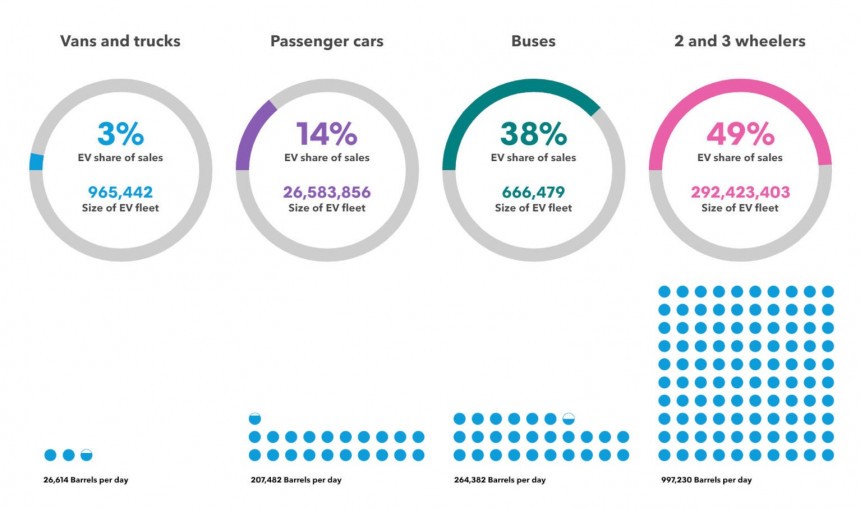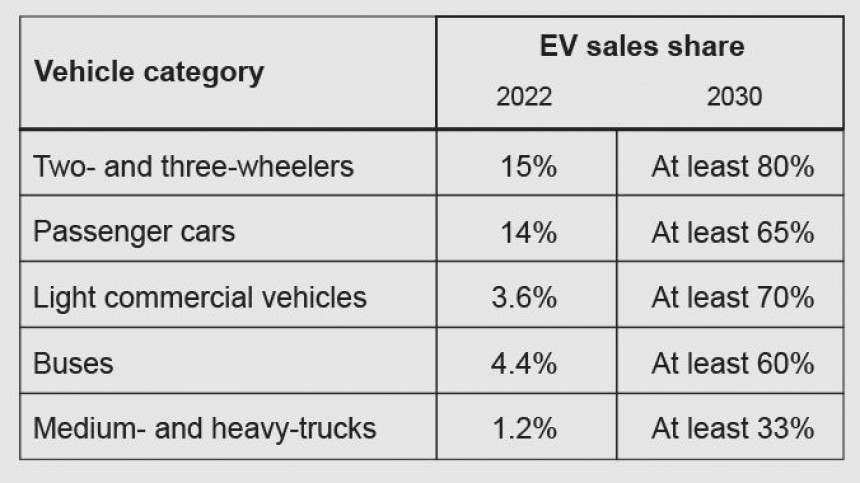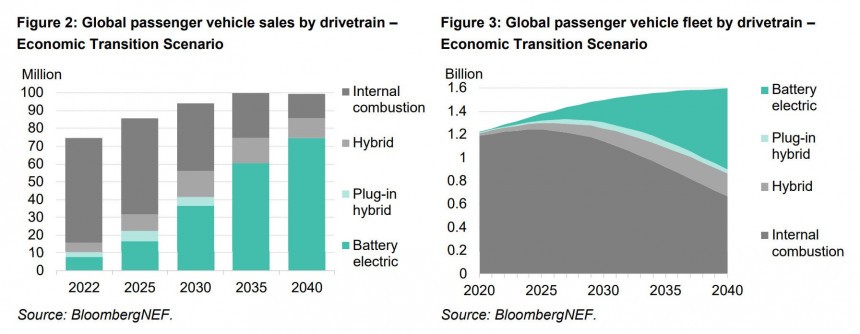There are a billion and a half road vehicles worldwide, with more than 90% of them using oil-based fuels, and by the half of this century, their number will double. How many of them will be "Zero Emission Vehicles" in less than thirty years from now? Predictions vary by a large degree, but there's a high risk that EVs and FCEVs can only replace ICEVs by a small margin.
Forecasting the long-term future is not an exact science. Still, investors in big industries like vehicle manufacturing, renewable mega projects, or fossil fuel exploration can't afford to believe in palm reading or a witch's orb.
Instead, they base their decision on all kinds of forecasts from several research companies out there that analyze a bunch of information. There's no such thing as a "perfect prediction"; there are only probabilities for a particular prediction to be correct, depending on a myriad of factors. The more data we have, the better.
For instance, I predict that around three billion road vehicles will operate worldwide in 2050. I base my assumption on several things. Firstly, about 1.3-1.4 billion vehicles already roam the world today.
Secondly, the International Organization of Motor Vehicle Manufacturers (OICA) shows a clear trend for increasing vehicle production. While several crises impacted production numbers in some years, the last two and a half decades saw a significant increase in the number of vehicles produced.
In 2000, 58.3 million passenger cars and commercial vehicles were manufactured. In 2010, the number grew by 33% to 77.6 million. In 2017, the production number was very close to a hundred million: 97.3 million, 25% more than in 2010 and 67% more than in 2000 (that's two-thirds more in less than two decades!).
While COVID-19 affected 2020 production numbers, which dropped to the 2010 level, the following years marked a rebound: in 2022, the total was 85 million – a recovery of almost 10% from 2019 in just two years!
I'll risk another prediction right now: by 2030, I expect the yearly global production of passenger cars and commercial vehicles to surpass 100 million units. Now, we should remember that around 25-30 million vehicles are scrapped yearly, which is expected to increase to nearly 50 million a year.
So this means that by 2050, there will be a surplus of around 1.3-1.5 billion vehicles compared to nowadays, when a similar number of vehicles is estimated to be in use worldwide. Unless a Third World War occurs, a new pandemic, or a zombie apocalypse – you get the picture.
There's a high chance I'm right because the same number is forecasted by the International Energy Agency (IEA), Goldman Sachs, or Bloomberg, which have way more data than I do. Now it's time to up the game with the next question.
According to IEA, in 2022, the power industry was responsible for 38% of CO2 emissions worldwide, while the transportation sector's share was only 20%. Still, the latter is the fastest-growing in terms of emissions. As 2023 was the first year SUV sales overtook those of other types of vehicles, transportation emissions are expected only to be higher.
That contradicts IEA's "Net Zero Emissions by 2050 Scenario (NZE Scenario)", stating that in 2030, road transport emissions must be slashed by at least one-third from today. For that to happen, zero-emission vehicle share in global sales must increase rapidly in the following years.
According to BloombergNEF's "Electric Vehicle Outlook 2023"estimations, 320 million electric vehicles were sold last year. Well, don't hold your breath, as 90% of them were 2- and 3-wheelers, and some 1.5 million were vans, trucks, and buses. As usual, the particle "EV" comprises both 100% electric vehicles and plug-in hybrid ones (falsely named plug-in electric vehicles).
Most important, though, is the oil displacement estimated by BloombergNEF for each segment, which translates into savings in CO2 emissions thanks to avoiding burning oil in internal combustion engines. This is the basis for estimating the increase rate for zero-emission vehicles in total sales needed for transportation to reach net zero by 2050.
IEA states that in 2030, the share of zero-emission passenger cars in global new car sales must be at least 65%. By then, the total number of EVs in use should reach about 300 million units. This is a lot – more than a ten-fold increase from 2023 in just six years! But it's also few – at that point, the number of ICE vehicles in use will most likely be close to 1.6-1.7 billion, five to six times more than the EVs.
By 2040, the IEA model requests the number of total EVs to pass one billion units; in 2050, it should double. Well, here we are: the optimistic scenario is that by mid-century, at least two billion of the vehicles in the world will have zero emissions. At the same time, there will be approximately a billion ICE on the roads. But this is the "nice to have" scenario.
This contradicts IEA's model, according to whom oil production should peak by 2030 and then drop sharply for the 1.5°C scenario to have a chance. Well, it should not come as a surprise that OPEC also forecasts that by 2045, there will be around 2.6 billion vehicles on the road, and combustion engines will power three-quarters of them.
Basically, oil producers expect that, by around mid-century, there will be only 700-750 million zero-emission vehicles globally. Much less than the two billion in IEA's optimistic scenario and close to the more-than-2.5°C disastrous scenario.
Frankly, OPEC's forecast is like the old saying, "Whose bread I eat, his song I sing." What about BloombergNEF's predictions, as it's one of the most trusted sources for investors? Well, its "Economic Transition Scenario" states that by 2040, the number of passenger EVs will reach approximately 730 million.
However, BNEF is bullish on the car industry's fast-paced production capacity. It predicts that by 2040, only 1.6 billion passenger vehicles will be in operation. Once again, a far-from-optimistic forecast: "Despite rapid EV adoption, less than 50% of the global passenger vehicle fleet is electric by 2040."
In the "Net Zero Scenario," BloombergNEF suggests, "Last internal combustion vehicle must be sold by 2038," while the number of passenger EVs in 2040 should be close to 1.1 billion (almost 50% more than in the "Economic Transition Scenario").
But do you really expect ICE vehicle production to stop in 2038 all over the world? Of course, this is a utopia. So, let me ask you another question.
IDTechEx's report "Fuel Cell Electric Vehicles 2024-2044: Markets, Technologies, and Forecasts" predicts that by 2044, FCEVs' share in total zero-emission vehicle sales will be less than 5%. That is to say, it's useless to talk about a hydrogen economy until mid-century.
In the passenger cars and light commercial vehicles segments, battery technology has an essential edge over hydrogen fuel cell technology. What's more important is that incentives for hydrogen are more costly than batteries, while refueling infrastructure is far from reasonable.
IDTechEx sees potential in the bus and truck segments, but technological evolution will be scarce in the following decades. There is also the problem of emissions, as a recent report on the comparative lifecycle for different categories of hydrogen production clearly highlights significant issues.
For instance, in California, the only American state operating a network of more than 50 H2 filling stations, two-thirds of the hydrogen comes from fossil fuels. Grey hydrogen (produced by steam methane reforming) has the highest lifecycle emissions, of 13.9 kg CO2 per kg H2.
Blue hydrogen almost halves that value if carbon storage is used, while turquoise hydrogen (produced by the thermal decomposition of methane) can lower emissions to only 6 kg CO2 per kg H2 at best. Green hydrogen, produced from water and renewable electricity sources, has the lowest values, between 0.6 to 2.5 kg CO2 per kg H2, depending on the renewable, wind, or solar.
Car markers and OEMs try to overcome fuel cell technology's high costs and obstacles by converting internal combustion engines to work with hydrogen. At CES 2024, Bosch proudly presented a hydrogen injector for ICE. At the same time, Hyundai announced its plans to focus on Waste-to-Hydrogen, using clean hydrogen generated from plastic, food, and organic waste.
French start-up NamX even made a "strategic move" by replacing the fuel cell system in its first SUV with a V8 ICE, which will use hydrogen as a fuel. The move is because of the high cost of rare earth metals for the fuel cell system. The problem is that H2 internal combustion engines are plagued by the same issue as diesel: certain levels of NOx due to the burning process. So, they're not quite "zero-emission vehicles."
The truth is that humanity must change many of its habits to avoid a catastrophic scenario because of global warming. The transition to zero-emission transportation isn't feasible if we keep promoting the idea of personal transportation and our vehicles become bigger and heavier. Predictions can change for the better only if we change.
Instead, they base their decision on all kinds of forecasts from several research companies out there that analyze a bunch of information. There's no such thing as a "perfect prediction"; there are only probabilities for a particular prediction to be correct, depending on a myriad of factors. The more data we have, the better.
How many vehicles will be worldwide in 2050?
Playing the game "Pick a Number" is of no use, obviously. Analyzing trends and complex data, on the other hand, is the right thing to do. Using computers and AI for modeling is even better. Add some statistics rules (by the way, Americans are probably the best in the world with statistics), and the probability for your answer to be close to accurate will be higher.For instance, I predict that around three billion road vehicles will operate worldwide in 2050. I base my assumption on several things. Firstly, about 1.3-1.4 billion vehicles already roam the world today.
Secondly, the International Organization of Motor Vehicle Manufacturers (OICA) shows a clear trend for increasing vehicle production. While several crises impacted production numbers in some years, the last two and a half decades saw a significant increase in the number of vehicles produced.
In 2000, 58.3 million passenger cars and commercial vehicles were manufactured. In 2010, the number grew by 33% to 77.6 million. In 2017, the production number was very close to a hundred million: 97.3 million, 25% more than in 2010 and 67% more than in 2000 (that's two-thirds more in less than two decades!).
While COVID-19 affected 2020 production numbers, which dropped to the 2010 level, the following years marked a rebound: in 2022, the total was 85 million – a recovery of almost 10% from 2019 in just two years!
So this means that by 2050, there will be a surplus of around 1.3-1.5 billion vehicles compared to nowadays, when a similar number of vehicles is estimated to be in use worldwide. Unless a Third World War occurs, a new pandemic, or a zombie apocalypse – you get the picture.
There's a high chance I'm right because the same number is forecasted by the International Energy Agency (IEA), Goldman Sachs, or Bloomberg, which have way more data than I do. Now it's time to up the game with the next question.
How many of them must be zero-emission vehicles?
Experts expect emissions from burning coal, oil, and natural gas to be 1.1% higher in 2023 than in 2022, close to 38 billion tonnes. The EU's Copernicus Climate Change Service (C3S) made it clear that 2023 was the warmest year since 1850. It is also grotesque that the same year, the COP 28 climate summit was presided over by one of the most prominent fossil fuels companies' CEOs.According to IEA, in 2022, the power industry was responsible for 38% of CO2 emissions worldwide, while the transportation sector's share was only 20%. Still, the latter is the fastest-growing in terms of emissions. As 2023 was the first year SUV sales overtook those of other types of vehicles, transportation emissions are expected only to be higher.
That contradicts IEA's "Net Zero Emissions by 2050 Scenario (NZE Scenario)", stating that in 2030, road transport emissions must be slashed by at least one-third from today. For that to happen, zero-emission vehicle share in global sales must increase rapidly in the following years.
Most important, though, is the oil displacement estimated by BloombergNEF for each segment, which translates into savings in CO2 emissions thanks to avoiding burning oil in internal combustion engines. This is the basis for estimating the increase rate for zero-emission vehicles in total sales needed for transportation to reach net zero by 2050.
What do others predict for ZEVs?
Let me start with the Organisation of Petroleum Exporting Countries (OPEC), as cars and trucks account for 60% of global oil consumption. The 13 countries in OPEC control 80% of global crude oil reserves, and the association forecasts an increase in oil production from 102 million bpd (barrels per day) in 2023 to 116 bpd in 2045.This contradicts IEA's model, according to whom oil production should peak by 2030 and then drop sharply for the 1.5°C scenario to have a chance. Well, it should not come as a surprise that OPEC also forecasts that by 2045, there will be around 2.6 billion vehicles on the road, and combustion engines will power three-quarters of them.
Basically, oil producers expect that, by around mid-century, there will be only 700-750 million zero-emission vehicles globally. Much less than the two billion in IEA's optimistic scenario and close to the more-than-2.5°C disastrous scenario.
Frankly, OPEC's forecast is like the old saying, "Whose bread I eat, his song I sing." What about BloombergNEF's predictions, as it's one of the most trusted sources for investors? Well, its "Economic Transition Scenario" states that by 2040, the number of passenger EVs will reach approximately 730 million.
However, BNEF is bullish on the car industry's fast-paced production capacity. It predicts that by 2040, only 1.6 billion passenger vehicles will be in operation. Once again, a far-from-optimistic forecast: "Despite rapid EV adoption, less than 50% of the global passenger vehicle fleet is electric by 2040."
But do you really expect ICE vehicle production to stop in 2038 all over the world? Of course, this is a utopia. So, let me ask you another question.
Do you believe fuel-cell vehicles are the future?
If you do, you probably also believe in fairy tales and Santa Claus. Predictions from research companies are simply mindblowing and should be a warning for policymakers.IDTechEx's report "Fuel Cell Electric Vehicles 2024-2044: Markets, Technologies, and Forecasts" predicts that by 2044, FCEVs' share in total zero-emission vehicle sales will be less than 5%. That is to say, it's useless to talk about a hydrogen economy until mid-century.
In the passenger cars and light commercial vehicles segments, battery technology has an essential edge over hydrogen fuel cell technology. What's more important is that incentives for hydrogen are more costly than batteries, while refueling infrastructure is far from reasonable.
IDTechEx sees potential in the bus and truck segments, but technological evolution will be scarce in the following decades. There is also the problem of emissions, as a recent report on the comparative lifecycle for different categories of hydrogen production clearly highlights significant issues.
For instance, in California, the only American state operating a network of more than 50 H2 filling stations, two-thirds of the hydrogen comes from fossil fuels. Grey hydrogen (produced by steam methane reforming) has the highest lifecycle emissions, of 13.9 kg CO2 per kg H2.
Blue hydrogen almost halves that value if carbon storage is used, while turquoise hydrogen (produced by the thermal decomposition of methane) can lower emissions to only 6 kg CO2 per kg H2 at best. Green hydrogen, produced from water and renewable electricity sources, has the lowest values, between 0.6 to 2.5 kg CO2 per kg H2, depending on the renewable, wind, or solar.
French start-up NamX even made a "strategic move" by replacing the fuel cell system in its first SUV with a V8 ICE, which will use hydrogen as a fuel. The move is because of the high cost of rare earth metals for the fuel cell system. The problem is that H2 internal combustion engines are plagued by the same issue as diesel: certain levels of NOx due to the burning process. So, they're not quite "zero-emission vehicles."
So, is the road transport going to be green by mid-century?
Ultimately, 2023's predictions for a net zero-emission road transport in 2050 are not optimistic. Electromobility is already struggling as governments can't afford to keep in place costly subsidy programs, while hydrogen hype almost stopped as companies and investors can't afford to sustain high costs for more extended periods.The truth is that humanity must change many of its habits to avoid a catastrophic scenario because of global warming. The transition to zero-emission transportation isn't feasible if we keep promoting the idea of personal transportation and our vehicles become bigger and heavier. Predictions can change for the better only if we change.
